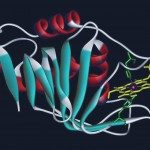Link to Pubmed [PMID] – 6255179
J. Virol. 1980 Aug;35(2):382-9
Nuclear RNA isolated from cells infected by herpes simplex virus type 1, strain F, was fractionated on formamide-sucrose gradients into two major classes, greater and less than 45S. These two classes of labeled nuclear RNA were hybridized to viral DNA fragments generated by digestion with the restriction enzymes HindIII and BglII. Early in infection, only a few DNA fragments hybridized to RNA, with slight differences between the two classes. Late in infection, all DNA fragments hybridized, showing that all viral RNA was present in large precursor molecules greater than 14 kilobases. The fragments that correspond to late gene products hybridized more of the small RNA than the large RNA. This suggests that the mRNA corresponding to late genes accumulated after the large precursors have been cleaved. Large (greater than or equal to 45S) and small (< 45S) nuclear RNA and cytoplasmic RNA from cells late in infection were hybridized in excess to in vitro-labeled HindIII M and L fragments. More than 50% of the HIndIII M fragment annealed with the large nuclear RNA, but only 36% of it annealed with the cytoplasmic RNA. The HindIII L fragment hybridized large nuclear RNA and cytoplasmic RNA to the same extent (30% and 26%). These results suggest that RNA complementary to the HindIII M fragment, which is the template for immediate early polypeptides, was regulated in the nuclei at the posttranscriptional level. This seems to suggest that temporal regulation of RNA cleavage occurs in the nucleus.

